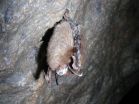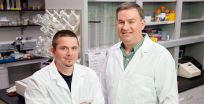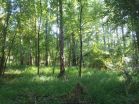(Press-News.org) CHAMPAIGN, Ill. -- A microbe found in caves produces a compound that inhibits Pseudogymnoascus destructans, the fungus that causes white-nose syndrome in bats, researchers report in the journal Mycopathologia. The finding could lead to treatments that kill the fungus while minimizing disruption to cave ecosystems, the researchers say.
The yeast Candida albicans produces the compound: trans, trans-farnesol.
Candida species are already present in caves where bats hibernate and have been isolated from the bodies of healthy, hibernating bats, said University of Illinois graduate student Daniel Raudabaugh, who conducted the study with Illinois Natural History Survey mycologist Andrew Miller. This suggests that tt-farnesol is unlikely to harm bats or damage cave ecosystems, Raudabaugh said.
"We're looking for a microbe that's already associated with bats, that lives in the cave environment and is not a problem for people or other cave life," he said.
C. albicans is a common resident of human intestines and is found in many other species. The yeast uses tt-farnesol for "quorum-sensing" - at high concentrations, the compound inhibits the growth of fungal projections called mycelia, causing Candida to revert from its invasive form to a more benign, yeast-like state. The compound also disrupts the process by which some bacteria form slimy biofilms that aid in their ability to infect and damage other cells.
"This chemical is known to inhibit other fungi, so we wanted to see if this would inhibit the fungus that causes white-nose syndrome in bats," Raudabaugh said.
"Several million bats have died of white-nose syndrome in the U.S., but European bats appear to survive the infection better," Miller said. "It is possible that the microbial makeup of European caves plays a role in bat survival there."
Raudabaugh first tested different concentrations of tt-farnesol against the white-nose fungus and found that, at the right concentrations, it effectively inhibited it.
"There are Candida species that already produce this concentration of tt-farnesol, which inhibits P. destructans at biologically produced concentrations," Raudabaugh said.
Further work must be done to search caves for Candida populations that produce tt-farnesol at effective concentrations.
"Inoculating hibernating bats with these microbes to use tt-farnesol as a control agent could increase the bats' chances of surviving the infection," Raudabaugh said.
The researchers also discovered that several other Pseudogymnoascus species are less sensitive to tt-farnesol. This suggests the compound could target the white-nose fungus specifically without disrupting other components of the cave ecosystem, Raudabaugh said.
"The goal is to preserve as many of the natural species as possible while eradicating P. destructans," he said. "That is the hope. And so far, it looks promising."
INFORMATION:
The Illinois Department of Natural Resources State Wildlife Grants Program and the Endangered and Threatened Species Program of the INHS supported this research. The INHS is a division of the Prairie Research Institute at the U. of I.
Editor's notes:
To reach Andrew Miller, call 217-244-0439; email amiller7@illinois.edu.
To reach Daniel Raudabaugh, call 217-244-0493; email raudaba2@illinois.edu. The paper, "Effect of Trans, Trans-Farnesol on Pseudogymnoascus destructans and Several Closely Related Species," is available online and from the U. of I. News Bureau.
A clinical study funded by the National Institutes of Health has found that young, single black women in South Africa adhered to a daily pill regimen to prevent HIV infection--an HIV prevention strategy known as pre-exposure prophylaxis, or PrEP. This finding is the first strong indication that this population at substantial HIV risk could accept and reliably adhere to daily PrEP dosing. Men who have sex with men (MSM) and transgender women (TGW) in New York and Thailand also successfully adhered to daily dosing.
PrEP--which consists of a daily dose of two antiretrovirals, ...
Dr. Michele Rodda describes two new tropical plants species from the Hoya genus, found on the world's third largest island Borneo. The genus is one of the largest and most complex plant groups in Asia. The first to be described in the paper, H. ruthiae, is characterised with its lack of coloured milk-like sap typical for most of the Hoya species, and H. bakoensis - with its strict preference for growing epiphytically (without causing any harm to its host) and rooting inside ant nests. The study is published in the open-access journal PhytoKeys.
Collected by Ruth Kiew ...
URBANA, Ill. - Controlled burning is widely used to maintain biodiversity and enhance regeneration of important deciduous tree species such as oak and hickory, but a recent University of Illinois study found that this practice also increases the growth of an aggressive species of invasive grass.
Microstegium vimineum (also called Japanese stiltgrass or Nepalese browntop) is an abundant non-native grass in southern Illinois where the study was conducted.
"We found that fire promotes the recruitment and growth of M. vimineum, particularly under moist soil conditions," ...
Although much progress has been made in combating the global HIV/AIDS pandemic, to halt new infections and end the pandemic, a combination of non-vaccine and vaccine prevention modalities will be needed. Even with these tools, significant implementation gaps must be closed, including the targeted deployment of proven prevention methods to the populations that need them most, says Anthony S. Fauci, M.D., director of the National Institute of Allergy and Infectious Diseases at the National Institutes of Health. Dr. Fauci addressed a special session at the 8th International ...
Irvine, Calif., July 21, 2015 - The 11 percent decrease in climate change-causing carbon dioxide emissions in the U.S. between 2007 and 2013 was caused by the global financial recession - not the reduced use of coal, research from the University of California Irvine, the University of Maryland, and the International Institute for Applied Systems Analysis shows.
Experts have assumed that the drop in emissions reflected a shift toward natural gas, which produces roughly half as much carbon dioxide per unit of energy as coal and was made cheap by the hydraulic fracturing ...
Only one in three older Americans have their diabetes under control as measured by guidelines set by the American Diabetes Association, new Johns Hopkins Bloomberg School of Public Health research suggests.
Some argue that ADA guidelines may be too stringent for some older adults. But even using less stringent measures, the researchers found, there are still many older Americans whose diabetes is not well managed, a condition that can lead to multiple long-term health problems ranging from kidney disease to blindness.
In a report published in the July issue of Diabetes ...
Most of us think of infants as tiny beings whose main business is to sleep, suck and cry, without much awareness of what is happening around them. It may come as somewhat of a surprise, then, to know that newborn brains are full of feverish activity and that they are already gathering and processing important information from the world around them. At just two days after birth, babies are already able to process language using processes similar to those of adults. SISSA researchers have demonstrated that they are sensitive to the most important parts of words, the edges, ...
One of the most basic yet important surgical skills to keep a patient alive and intact may be closing wounds. It seems that doctors will now get the job done with more ease thanks to new, nontoxic surgical glue that instantly seals a bleeding wound and helps it heal without a scar or inflammation.
Inspired by nature's wonders, Korean scientists at Pohang University of Science and Technology (POSTECH) have developed a light-activated, mussel protein-based bioadhesive (LAMBA) that works on the same principles as mussels attaching to underwater surfaces and insects maintaining ...
PROVIDENCE, R.I. [Brown University] -- When the HOPE VI community revitalization project in the disadvantaged Birmingham, Ala., neighborhood of Ensley reached the phase of building walking and biking paths, green spaces, and improved lighting in 2010, two things happened, according to a new study: First, residents developed specific expectations that leisure exercise would become more plausible, and then they followed through and got out there.
Before the neighborhood's revitalization, launched in 2006 with funding from the federal program Housing Opportunities for People ...
A vaccine that protects against a wide variety of influenza viruses (a so-called universal flu vaccine) is a critical public health goal given the significant rates of illness and death caused by seasonal influenza and the potentially devastating effects of a pandemic influenza strain. Now, researchers from the National Institute of Allergy and Infectious Diseases (NIAID), part of the National Institutes of Health, have devised a way to induce protective immunity in mice against a wide array of influenza viruses.
Instead of trying to predict which influenza virus strains ...





